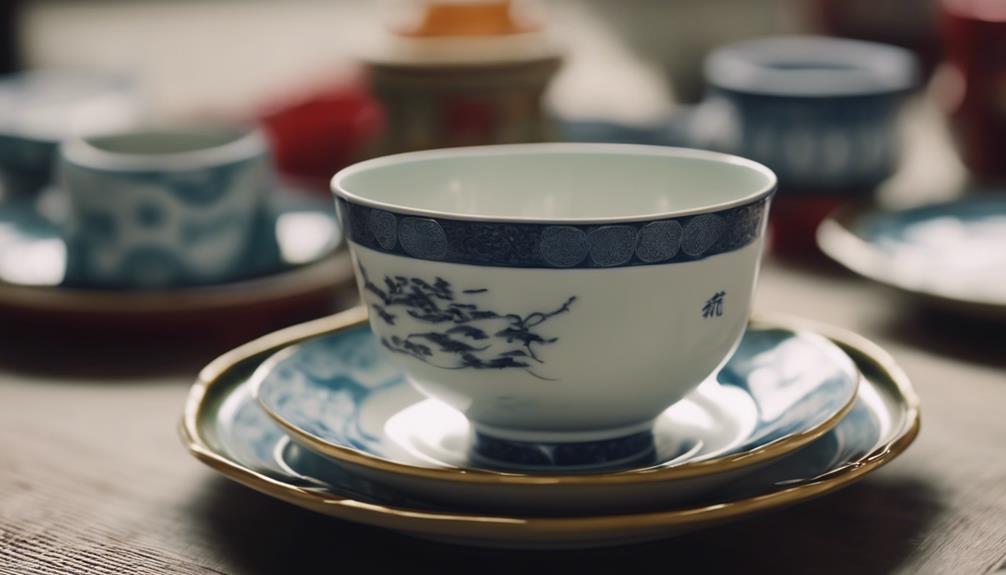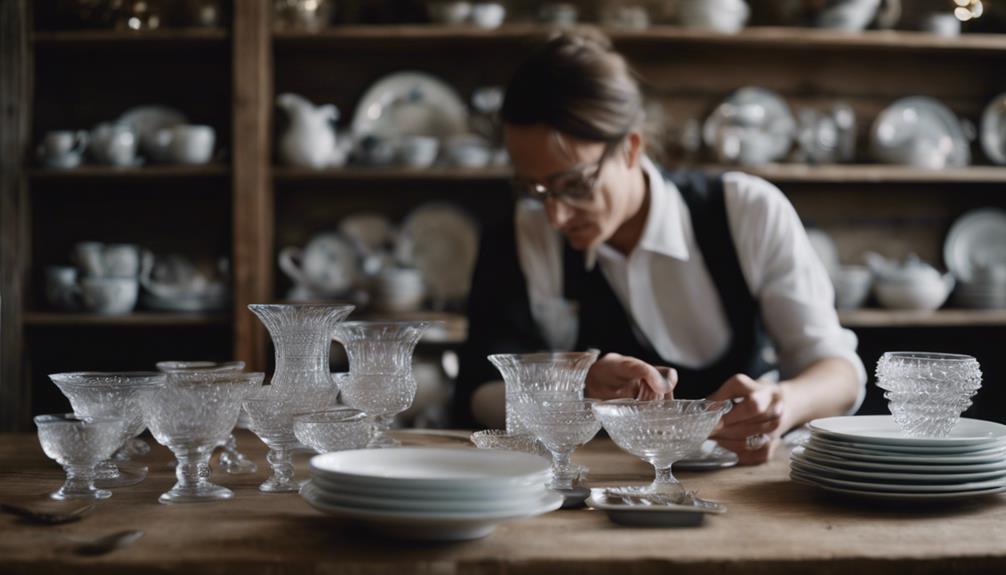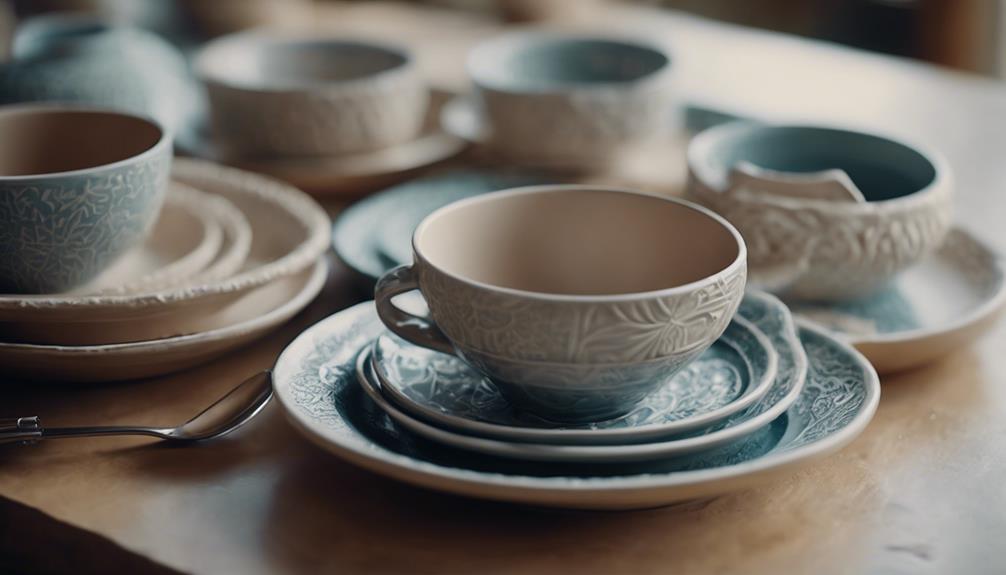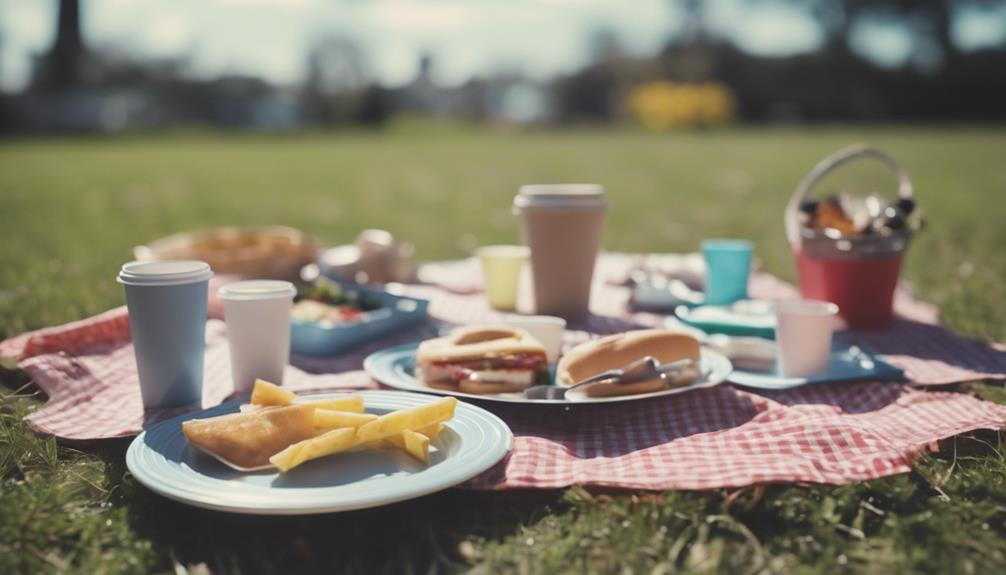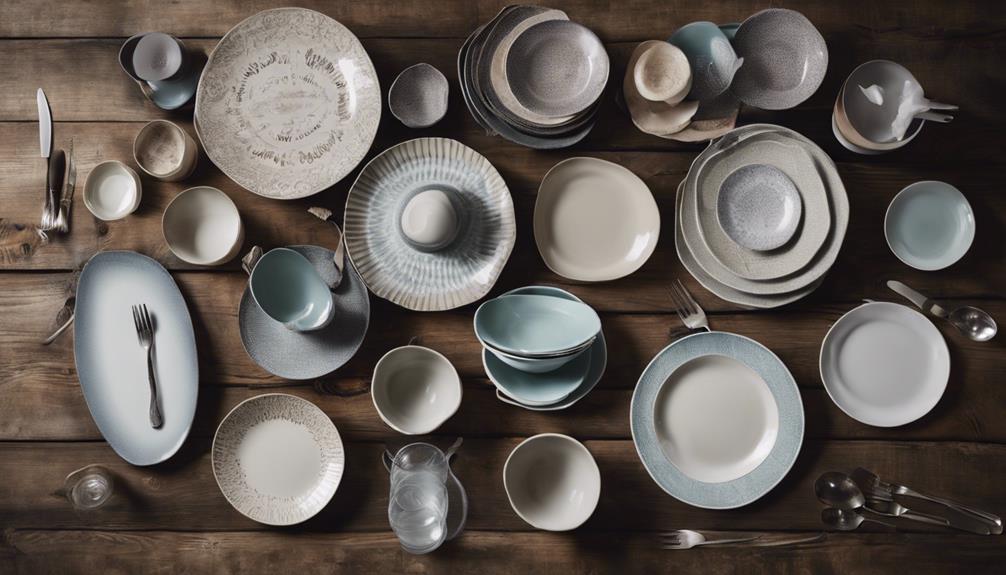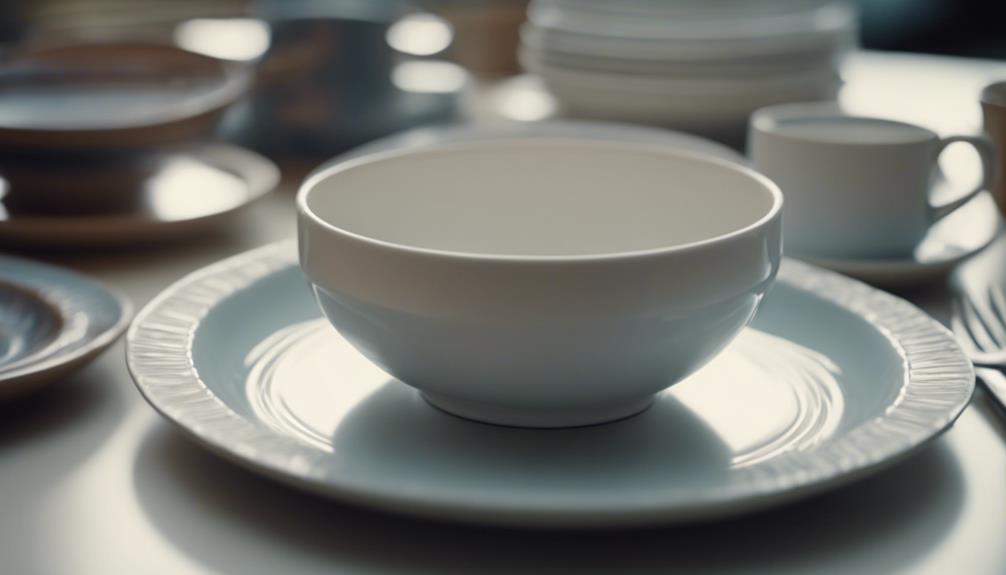Chinese tableware with a rich heritage dating back to ancient dynasties consists of Fine China, Bone China, and Porcelain, all known for their exquisite beauty and lasting durability. While Fine China exudes elegance, it is not suitable for use in the microwave or dishwasher. On the other hand, Bone China, identified by a trademark, provides a warm and translucent appeal. Careful maintenance, such as hand-washing with gentle products and avoiding harsh methods, is required. When choosing between them, factors to consider include durability, maintenance, and design. Porcelain, which is highly durable, is ideal for everyday use. Familiarizing yourself with the unique qualities of each type will assist you in making an informed decision for your table setting requirements.
Key Takeaways
- China tableware includes Fine China, Bone China, and Porcelain.
- Crafted from materials like kaolin and bone ash for elegance and durability.
- Known for delicate beauty, refinement, and luxurious standards.
- Not safe for microwave or dishwasher; requires gentle hand-washing.
- Originated in regions like Dehua and Jingdezhen during the Han and Tang Dynasties.
Origins of China Tableware
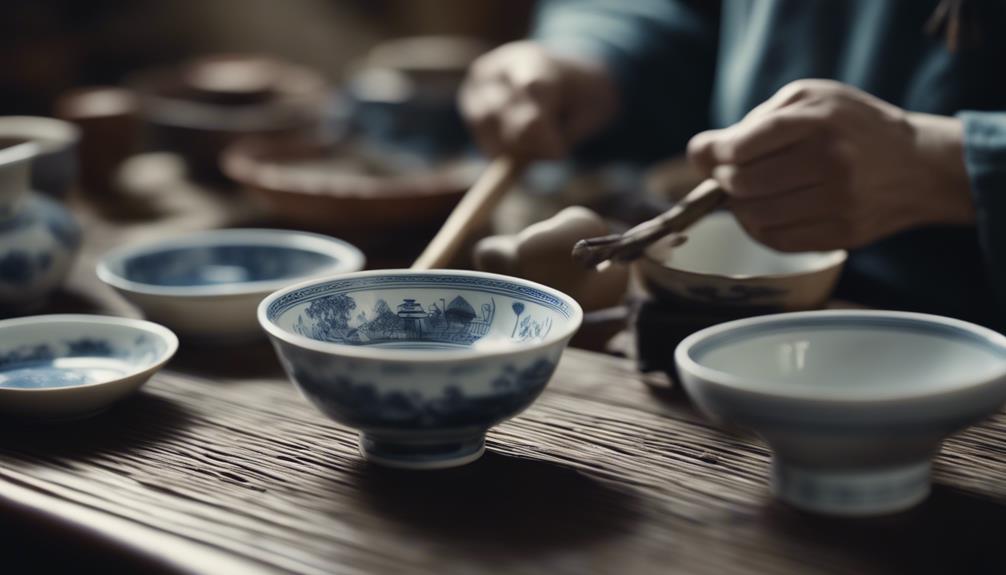
During the Han and Tang Dynasties in China, the origins of China tableware emerged with intricate designs and exceptional craftsmanship. The regions of Dehua and Jingdezhen became renowned for producing high-quality chinaware, marking a golden age for art and culture in China. Various types of China tableware such as Fine China, Bone China, and Porcelain showcased distinct qualities, each reflecting the skilled craftsmanship of the artisans.
These types of tableware were known for their delicate beauty, durability, and association with elegance and sophistication. The craftsmanship during these Dynasties set a standard for future generations, with China tableware becoming synonymous with luxury and refinement. The intricate designs and attention to detail in the production of China tableware during this period laid the foundation for the reputation that Chinese ceramics hold to this day.
Characteristics of Fine China
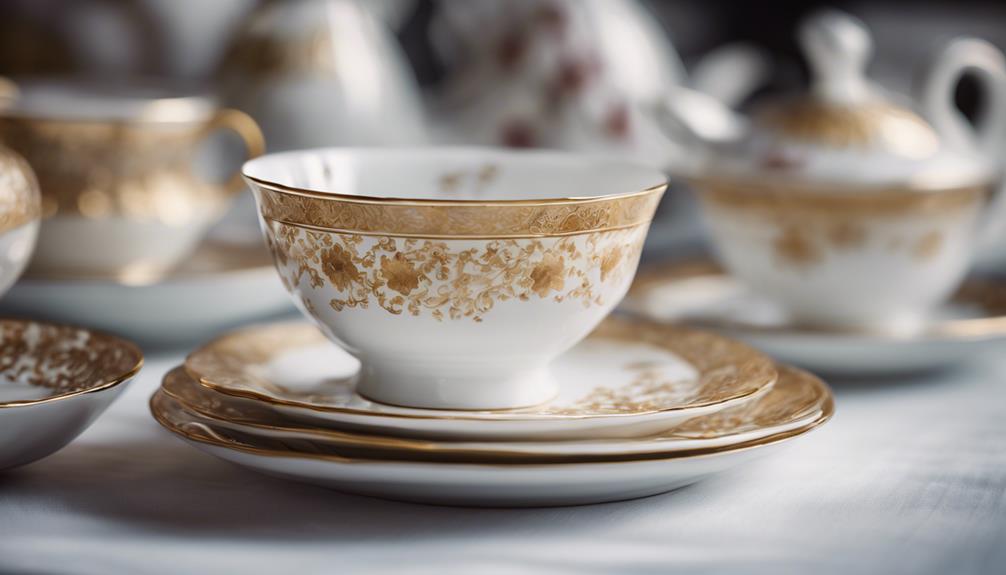
Exhibiting a smooth, white, and lustrous appearance when glazed, Fine China is a type of tableware that originated during the Tang dynasty in China, crafted from kaolin, a type of white clay. Fine China is often associated with elegance and sophistication, making it a popular choice for special occasions and formal dining settings. This delicate tableware requires careful handling and should not be used in microwaves or dishwashers to preserve its beauty and quality.
To better understand the characteristics of Fine China, let's compare it with Porcelain and Bone China in the table below:
| Characteristic | Fine China | Porcelain |
|---|---|---|
| Material | Kaolin clay | Kaolin clay |
| Appearance | Smooth, white, lustrous when glazed | Translucent, white, elegant |
| Usage | Special occasions, elegant dining settings | Everyday use, formal occasions |
Fine China stands out for its exquisite look and is a perfect choice when you want to add a touch of sophistication to your dining experience. Remember to handle it with care to enjoy its beauty for years to come.
Bone China Vs Fine China
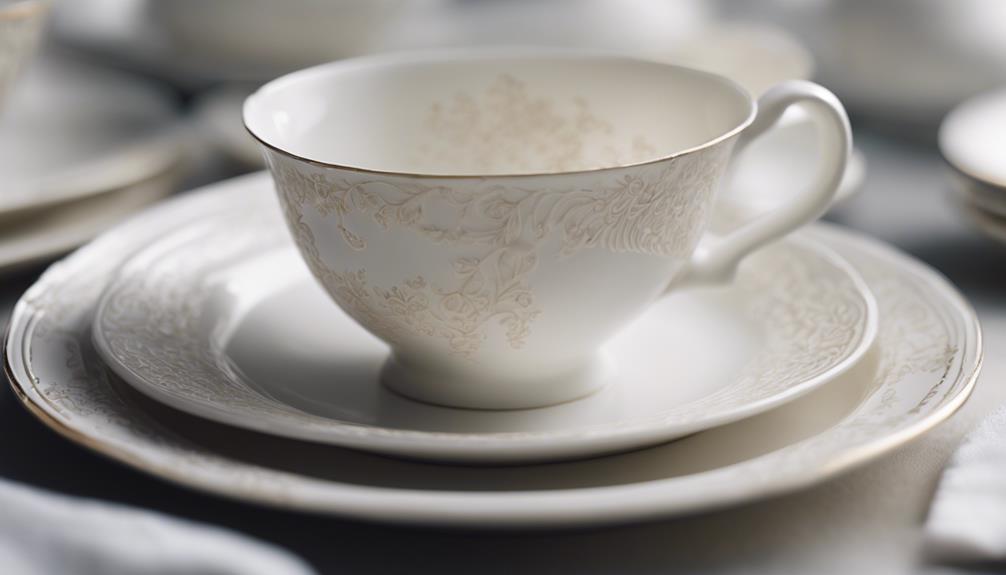
When comparing bone china and fine china, it's crucial to consider the material differences, with bone china containing bone ash for a warmer white tone and greater translucency.
The production process also sets them apart, as fine china is crafted from kaolin clay, while bone china includes cow bone ash in its composition.
Understanding these distinctions can help you appreciate the unique qualities and origins of each type of china tableware.
Material Differences
Bone china and fine china differ significantly in their composition, resulting in distinct characteristics and suitable uses. Bone china contains 25-45% bone ash, giving it a warmer white tone and greater translucency compared to fine china, which is made from kaolin, a type of white clay.
Bone china pieces are often marked as such on the underside, along with the company hallmark. Fine china, not safe for microwave or dishwasher use, requires gentle handwashing to prevent damage.
European companies like Spode began producing bone china in 1790, aiming to match the quality of Chinese porcelain. Understanding these material differences can help you choose the right type of china for your specific needs and occasions.
Production Process Comparison
In the production process of china tableware, bone china and fine china undergo distinct methods that result in their unique characteristics and qualities. Bone china contains 25-45% bone ash, giving it a warmer white tone and greater translucency compared to fine china. Bone china is made using ingredients like feldspar, ball clay, quartz, kaolin, and cow bone, while fine china is typically crafted from kaolin, a type of white clay.
The difference in materials used is important in understanding the manufacturing process of these two types of china. European companies like Spode started producing bone china in 1790 to match the quality of Chinese porcelain. Bone china pieces are often labeled accordingly to differentiate them from fine china, which has a smooth, white, and lustrous appearance ideal for special occasions.
Care Tips for China Tableware
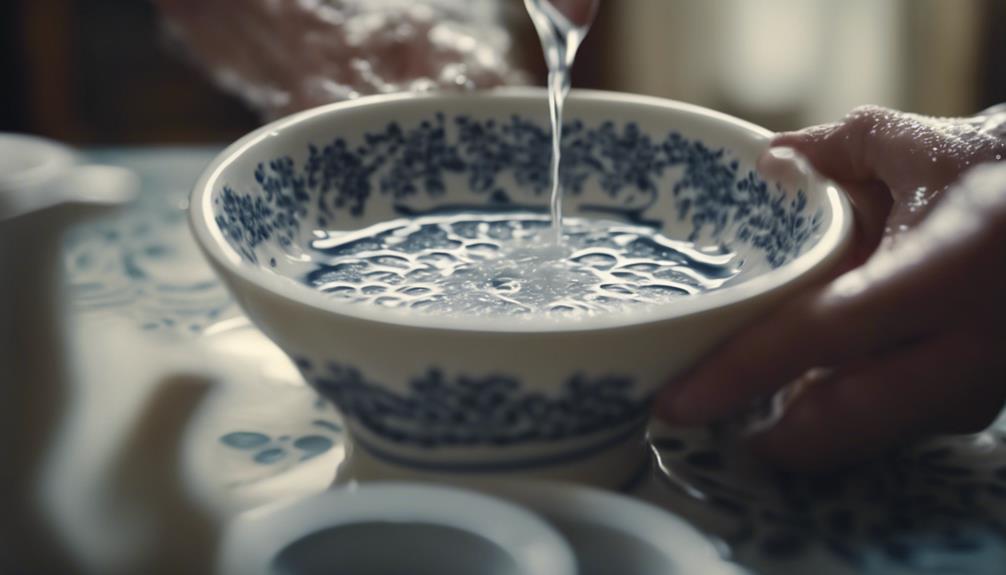
To properly maintain your china tableware, remember to hand-wash it to protect delicate accents such as gold rimming. Here are some essential care tips for your delicate china and porcelain pieces:
- Hand-Washing: Always hand-wash your china tableware to prevent damage to delicate accents and designs. Avoid harsh detergents and abrasive scrubbers that can scratch or wear down the surface.
- Storage: Store your china tableware in a dedicated cabinet away from direct sunlight, heat, and humidity. Proper storage helps maintain the quality of your pieces and prevents them from getting chipped or cracked.
- Not Suitable for Microwave or Dishwasher: Most china tableware, especially those with delicate decorations, aren't suitable for microwave or dishwasher use. These pieces require gentle cleaning with mild soap and a soft cloth to preserve their beauty and integrity.
Types of China Tableware
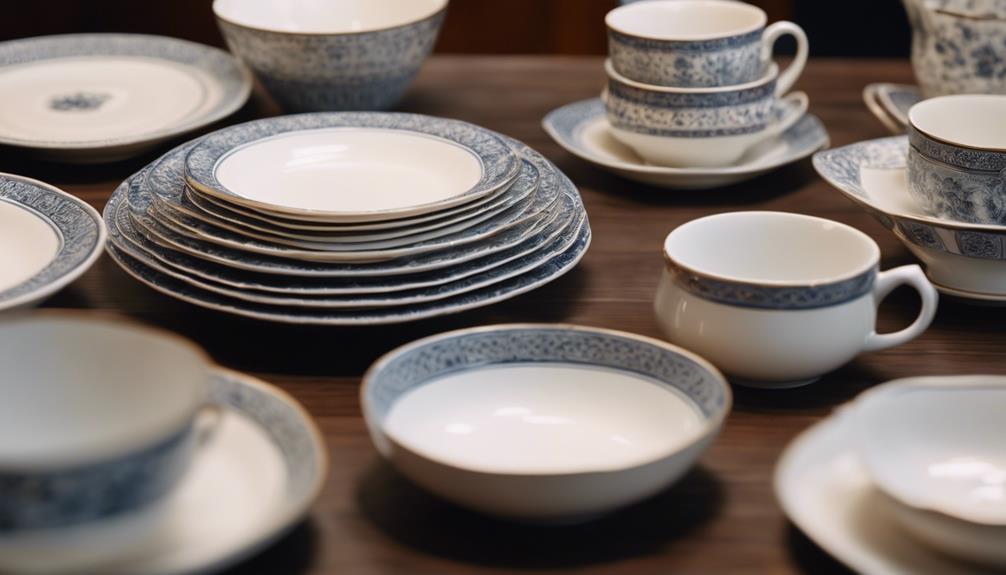
When exploring the world of china tableware, you'll encounter a variety of types distinguished by their unique qualities and characteristics. Fine China, Bone China, and Porcelain are the main types of China tableware you'll come across.
Fine China and Bone China both involve the addition of bone ash during the production process, giving them a delicate appearance and translucency. The main differences lie in the firing temperature; Bone China is fired at lower temperatures than traditional China, resulting in a more delicate finish.
Porcelain, although similar to China, is fired at higher temperatures, making it more durable and suitable for everyday use. The difference between China and Porcelain mainly comes down to sturdiness and durability.
Price points can vary among these types, with Bone China often being more expensive due to its intricate production process and elegant finish. Each type has its own unique charm, catering to different preferences and needs.
Choosing China Tableware for Events
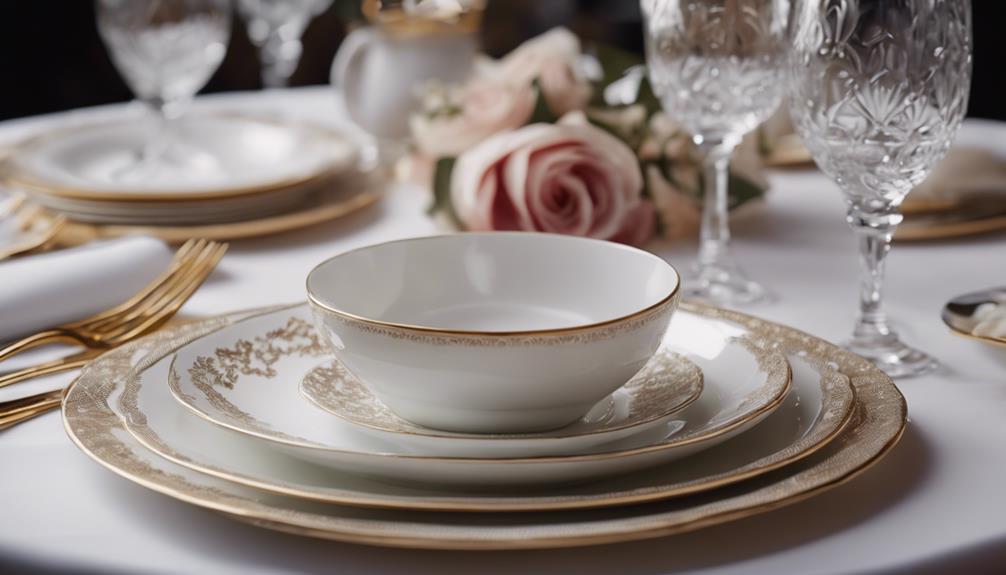
For selecting china tableware to elevate your event, consider the design, durability, and care requirements that align with your vision and practical needs. When choosing China tableware for events, keep in mind:
- Durability: Opt for fine China or Bone China based on the level of sturdiness required for your event. Fine China offers exceptional durability and non-porosity, ideal for frequent use, while Bone China is lightweight yet strong, perfect for a more delicate touch.
- Design: Select China tableware that complements the theme and ambiance of your event. Whether you prefer intricate patterns, classic styles, or modern designs, the aesthetic appeal of the tableware can enhance the overall elegance of the occasion.
- Care Requirements: Consider the maintenance needs of the China tableware. Some pieces may require special care like hand-washing, especially those with delicate features such as gold accents, to maintain their longevity and pristine condition throughout your event.
Choosing the right China tableware can add a touch of sophistication and elegance to your events, creating a memorable dining experience for your guests.
Differences Between China and Dinnerware
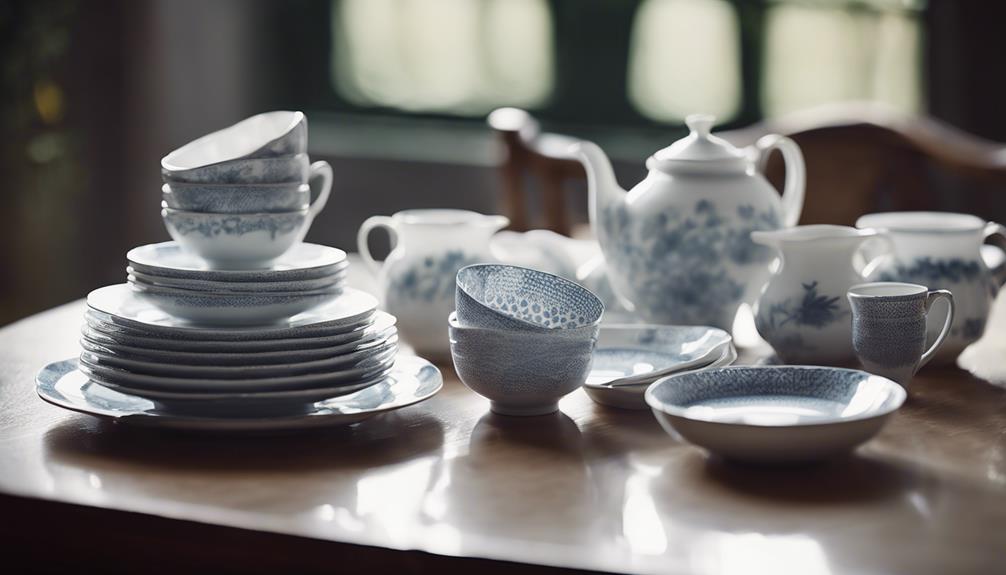
Consider the distinct materials utilized in china tableware and dinnerware to comprehend their unique characteristics and suitability for various dining preferences.
China tableware, including fine china and bone china, is crafted from a blend of clay, kaolin, feldspar, and quartz, known for its elegance and strength. These pieces often feature delicate accents like gold but require special care such as hand-washing. Porcelain, a type of china tableware, originated in Europe and is fired at higher temperatures, making it durable and distinctive compared to traditional china.
On the other hand, dinnerware encompasses a broader range of materials like stoneware, earthenware, melamine, and vitrified glass, offering options that are dishwasher-safe and more suitable for everyday use.
Understanding these differences can help you make informed decisions based on care requirements, budget, and personal preferences when selecting tableware for different occasions.
Frequently Asked Questions
Why Is Tableware Called China?
Tableware is called 'china' because of its origin in China during the 8th century. The term 'china' specifically refers to top-quality dinnerware made from clay, kaolin, feldspar, and quartz.
It boasts an elegant and delicate appearance, often adorned with intricate designs and gold accents. The craftsmanship of china tableware dates back to the Han and Tang Dynasties, making it synonymous with high-quality, durable, and beautifully designed tableware globally.
What China Is Used for Tableware?
When setting the table, you'll want to reach for high-quality china. This type of tableware is made from a blend of clay and other minerals, fired in a kiln for durability and intricate designs.
Fine china and bone china are popular choices, each with its own unique qualities. China tableware is known for its elegance, durability, and delicate features like gold embellishments.
It's the perfect choice for adding a touch of sophistication to any dining experience.
Is China the Same as Ceramic?
Yes, China and ceramic aren't the same. China tableware is a specific type of ceramic made from clay, kaolin, feldspar, and quartz.
This composition and the firing process used makes China tableware distinct. The result is a delicate yet durable product with a white and translucent finish.
China tableware is valued for its elegant appearance, chip resistance, and strength, making it a popular choice for special occasions and fine dining.
What Is the Difference Between China and Regular Plates?
When choosing between china tableware and regular plates, consider their differences.
China tableware, crafted from clay and other materials, offers elegance for special occasions. In contrast, regular plates made of ceramic or glass are more durable for everyday use.
China tableware requires delicate care, while regular plates are dishwasher safe.
The choice depends on your need for formal elegance or practical functionality. Choose what suits your dining preferences best.
Conclusion
To sum up, China tableware is a beautiful and elegant option for special occasions or everyday use. Its origins date back centuries and its fine craftsmanship sets it apart from regular dinnerware.
Whether you choose bone china or fine china, proper care is essential to maintain its beauty. Consider the type of china tableware that suits your needs and preferences, and enjoy the timeless sophistication it brings to your dining experience.
